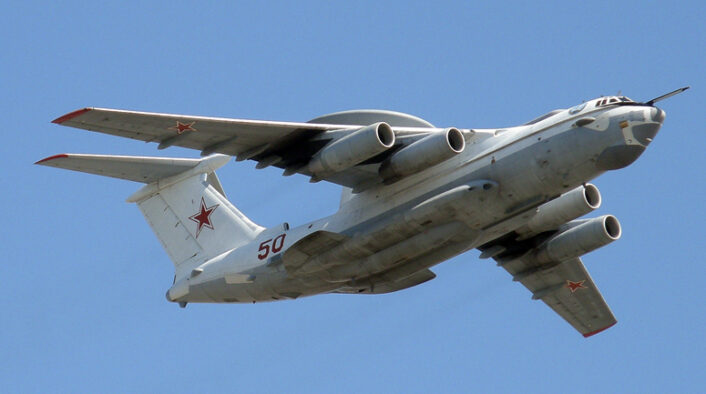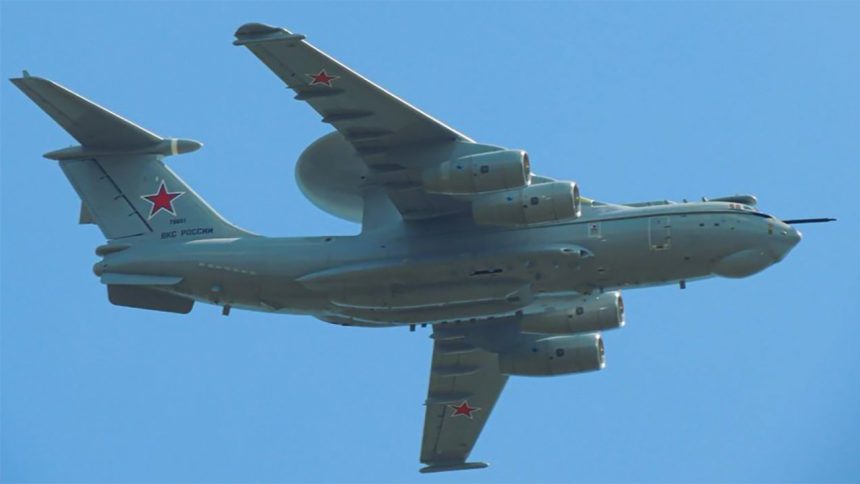The A-100 project had been delayed as sanctions cut Russia’s access to modern Western electronics and microprocessors.
The Russian A-100 “Premier” AEW&C (Airborne Early Warning and Control) aircraft, currently being developed, is being prepared for a new radar system. The RuAF (Russian Aerospace Forces) have long been known to be deficient in airborne radars and are looking to fill this technological gap.
Social media posts also emerged showing three pictures capturing a bottom view of an A-100 flying overhead. “The newest A-100 during a test flight,” the post said.
It will be a while until testing wraps up and the aircraft enters mass production and reaches RuAF units. Given the small fleet of AWACS and the loss of two A-50s to Ukrainian anti-air fire, it warrants a look at the RuAF’s prospects, especially before the imminent arrival of the F-16s.
As we reported earlier this year, the RuAF lost two A-50Us to Ukrainian AD (Air Defense) missile fire. Recently, a U.S. Army officer revealed that the first was shot down using the SAMbush (air ambush) tactic with a U.S.-made Patriot missile, while the second one was previously attributed to a S-200/SA-5 missile.
🇷🇺 The newest A-100 during a test flight. pic.twitter.com/XClJHRwUBp
— Lord Bebo (@MyLordBebo) June 12, 2024
New tests
Reports from Russia said the experimental prototype is “being prepared for the final stage of full-scale testing” of the high-energy” dual-mode “passive or active” S-band array. The report quoted military expert Evgeny Damantsev, who mentioned the new radar’s “noise immunity has also been increased several times.” This feature had not been available in the previous Shmel-M radar of the A-50U.
Additionally, “with new economical PS-90A-76 turbofan engines, the operating radius can be 4250 to 4750 km.” It is not clear if the prototype is already flying the new engine or if it will be installed later.
A-50U Mainstay and A-100 Premier
The A-100 ‘Premier’ is a significant advancement over the A-50U ‘Mainstay’, with the latter being an upgraded version of the Soviet-era A-50, which entered service in 1984. The midlife upgrade to the ‘U’ standard (A-50U) was launched in 2006.
That program included a new computing system, digital signal processing capability and replacement of many analog units with modern electronics. Russian reports say the program also includes the reduction of the aircraft’s weight, introducing large LCD monitors, a new mission computer and navigation system.
‼️ Hey folks. Enjoy fresh pics of future 🇷🇺 RuAF AEW&C A-100 «Prem’er».
The a/c performing test flights over Ulyanovsk (Aviastar a/c company).
Looks like A-100 left Taganrog to avoid to be hit with Ukrainian missiles/UAVs.
Courtesy: Tg channel ZOV_voevoda pic.twitter.com/OFNotHPB1Q
— KURYER🤔 (@RSS_40) June 12, 2024
The upgrade program is carried out by the Vega electronics company, part of Ruselectronics, in partnership with Beriev. The carrier aircraft, an Ilyushin Il-76MD-90A transport plane, is manufactured at the SP Aviastar factory in Ulyanovsk in western Russia.
The A-50U can track up to 150 targets at 595 km, compared with 45 targets at 225 km for the original A-50. The A-100, with the new AESA (Active Electronically Scanned Array) radar, can track 300 targets at a distance of 643 km. The aircraft can reportedly fly for at least 10 hours without refueling.

According to a Russian military aviation expert, there are two known aircraft related to the A-100 program. One is the A-100LL, with “LL” standing for “flying laboratory.” The aircraft was converted from an existing A-50 aircraft, bearing the registration “RF-93953.” The second is the A-100 prototype with the serial “RF-78651”, converted from an Il-76MD-90A. This is the one captured in the latest photos emerged online.
Current fleet strength
On Jan. 14, 2024, Ukraine shot down an A-50 over the Sea of Azov along with an Ilyushin Il-22 radio relay plane. This was followed by another shoot down of an A-50 on Feb. 23 in the same region. Colonel Rosanna Clemente, Assistant Chief of the 10th Army Air and Missile Defense Command, revealed during the Field Artillery Association’s Fires Symposium earlier this week that the Jan. 14 shoot down was accomplished by using a German-provided Patriot system.
Prior to the beginning of the war, the RuAF was known to have taken delivery of seven A-50Us. One was delivered before the war in Dec. 2021. In Sep. 2023, Russia’s United Aircraft Corporation (UAC) announced that it handed over another A-50U, RIA Novosti said. Presumably, this is the eighth A-50U. Claims about the RuAF also receiving a ninth A-50U cannot be verified and there is little evidence to support this.
With two A-50Us shot down earlier this year, the total A-50U fleet shrinks down to six aircraft (seven if the unverified delivery is also taken into account). Satellite pictures from Sep. 2023 also showed an A-50 at Syria’s Khmeimim air base. This means, in the European theater before Ukraine and NATO, Russia has five to six A-50Us.
🇺🇦⚔️🇷🇺 A Russian Beriev A-50 (NATO reporting name: Mainstay) airborne early warning and control aircraft valued at USD $300,000,000, has been shot down. pic.twitter.com/NuYiLlVbso
— Astraia Intel (@astraiaintel) February 23, 2024
On Jul. 3, 2023, Russian defense minister Sergei Shoigu called for accelerating the induction of more AEW&C aircraft, implying the RuAF’s weakness in the area. “Two issues are being submitted for consideration. The first concerns the implementation of a state contract for the repair and modernization of the A-50 aircraft. Timely modernization of the fleet will significantly increase the effectiveness of troop groups,” Shoigu said.
Modern AEW&C and Russia’s weakness in electronics
The lack of a large and ready AEW&C fleet may have also contributed to many tactical successes of Ukrainian-launched Storm Shadow/SCALP-ER air-launched cruise missiles (ALCM). AEW&C systems can also detect LO (Low-Observable) land-strike missiles and tip-off ground-based radars or other airborne fighters.
But they need new electronics, powerful computing and higher data processing to track the current generation of cruise missiles, stealth/LO aircraft, enemy ground-launched air defense missiles, coordinating with friendly fighters using data links while incorporating updates from satellites.
Besides just tracking airborne targets, AEW&C aircraft are also expected to have ESMs (Electronic Support Measures) to detect and classify adversary radar emissions and share the information with friendly aircraft and long, medium-range SAMs (Surface-to-Air Missiles). These include the S-400 and S-300, which function as networked IADS (Integrated Air Defense System).
The Russian report did say that the radar also “operates in electronic reconnaissance mode,” and is “equipped with secure information exchange terminals”, possibly meaning data links. These issue “target designation for low-altitude targets to Su-30SM1/2 and Su-35S fighters, S-400, S-300V4, Buk-M3A air defense systems.”
The A-100 AWACS will therefore have the latest microprocessors, electronics and sophisticated electronic circuitry. But reports had acknowledged how the project had been delayed owing to access to modern computer hardware and electronics due to U.S. and European sanctions. The situation persisted since the time of the USSR when the U.S. blocked the flow of technology to Moscow.
The economic crisis after the collapse of the USSR caused its technology sector to be further neglected. Additional U.S. and European sanctions at the beginning of the 2014 Donbass War and the February 2022 war further restricted Moscow’s imports of such Western devices. Russia did manage to access these from third parties and countries that did not recognize the sanctions against Russia, including the UAE, Turkey and China.
U.S. and European electronics therefore continued being found in Russian cruise missiles and Geran-2 kamikaze drones. It is only since mid-2022 that Russia has galvanized its private technology sector, state research institutes and academia for self-reliance in electronic and sensor manufacturing, particularly for its drone sector.
Russian planners know the long-term unsustainability of circumventing Western sanctions. It can be said that this technological and industrial situation also impacted the modernization of the Russian AEW&C fleet.
Russia’s options before the Ukrainian F-16s
On Oct. 25, 2023, TASS quoted Russian defense officials who said the S-400 had worked in “conjunction” and “in tandem” with the A-50 “against enemy aviation.” “The S-400 air defense system was fired at its maximum range at targets that at the time of destruction were at an altitude of approximately 1,000 meters while new warheads of anti-aircraft guided missiles were used.”
Another TASS report also quoted Defense Minister Sergei Shoigu, as he was interacting with troops, claiming they “shot down 24 aircraft in 5 days,” leading up to that day. It is unclear if all of these downed Ukrainian planes were a casualty of the A-50-S400 team. Shoigu did not offer a detailed breakup of the 24 Ukrainian aircraft.
In Dec. 2023, Russian Radio Sputnik quoted unnamed officials who said the S-400’s ultra-long range 40N6 missile (400 km) will be vital in this S400-A-50 teaming. The 40N6 would also be suitable for the possible flight profile Ukrainian pilots would fly in the F-16s. Ukraine cannot afford to pilot the jets at medium and high altitudes during the entire mission to prevent detection.
Most likely, they would fly a ‘low-high-low’ profile, where they travel a certain distance at low altitudes before climbing up rapidly in a steep trajectory, releasing the air-to-ground munitions and then turning back. “The S-400 will be able to hit F-16 aircraft with 40N6 missiles immediately after takeoff and climb when deployed at forward-based airfields,” said the official.
It is not clear if the jets will have on-board EW equipment like self-protection jammers, which can disable the 40N6 missile when it has switched to active homing during the terminal phase, or towed radar decoys.
The 40N6 missile has a dual-mode semi-active or active radar homing. It climbs to a designated altitude, and then guidance switches to search and destroy mode. The active homing head also covers the ground-radar’s blind spot due to the earth’s curvature.
This makes it effective also against low-altitude targets. Naturally, the missile’s onboard radar will have limited power and range compared to a larger radar on an aircraft, especially the one on an AEW plane like the A-50. The missile also has a proximity fuse with a fragmented warhead, but it is not clear if the 40N6 can receive mid-course updates from the S-400 or the A-50U via a data link or two-way radio link.
However, Ukraine had been recently successfully striking Russian S-400s with ATACMS (Army Tactical Missile System) variants that fire cluster munitions. This also means Ukraine might expend its ATACMS rockets’ stock, as the strikes on the Belbek air base at Crimea and Mospyne involved a salvo fire, with a number of missiles claimed to have been shot down.
The Russian expert also said the F-16s and the air-to-air missiles for Ukraine “are older, less capable versions”, although the weapons that will come with the U.S.-made fighters have not been disclosed. “Russian fighters such as the Su-30SM and Su-35S are superior in quite a few areas.” Moreover, Russia’s ground-based air defense, including the S-400, is still active, suggesting the Russian armed forces have not expended its inventory and that Russian factories continue producing it.









